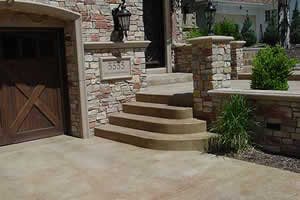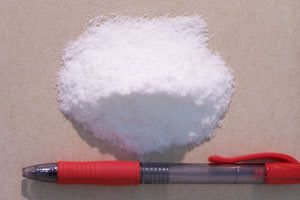Non-Slip Additives for Concrete Sealers and Other Products
Sealed decorative concrete, either exterior or interior, can become very slippery when it gets wet. But with most decorative concrete, a broom finish is not ideal. Your customer doesn't want that beautiful texture you just created screwed up with a broom-or if he does, tell him you have a better idea.

Exterior decorative installations lend themselves to use of a grit additive to the sealer. QC Construction Products

Polymer grit additives become transparent when added to a sealer. QC Construction Products
Find concrete contractors near me
Gritty Sealers
Several manufacturers sell a grit that can be added to the final sealer coat to increase the coefficient of friction. Chris Sullivan, National Sales Manager for QC Construction Products and one of the Concrete Network's technical experts, says that the best material to use for this purpose is a grit made from ground up polyethylene. He notes that silica sand or aluminum oxide beads have also been used, but these materials can change the appearance of decorative concrete.
The advantages of the plastic grit are that it is nearly transparent and that it is so light it stays suspended throughout the sealer. This allows new grit to be exposed as the sealer wears. It also allows it to stay in suspension during application, although one decorative concrete veteran says that you should still stir the grit up occasionally to make sure it stays completely mixed.
Proper mixing is important for these products in order to avoid clumping. The typical dosage is 1 pound of grit to 5 gallons of sealer. Follow the manufacturer's instructions, which usually includes mixing it into a small portion of the sealer with a mechanical mixer then mixing that into the bulk of the sealer. It is possible to spray sealers with grit with the proper high pressure sprayer, but rolling it on is probably safer.
The original product of this type is SharkGrip from H&C Concrete Products. Several other manufacturers provide a similar product, including Proline Concrete Tools (Dura-Grip), NewLook International (Gription), Increte Systems (Shur-Grip), and Specialty Concrete Products (Poly Grip). These products usually include spherical plastic beads. "The smooth round shape keeps from wearing sealer as fast as sharp angular quartz," says SCP's Marshall Hoskins.
Slip-Resistant Tape for Concrete
In some cases, you may be faced with concrete that is slippery but only needs slip resistance in certain spots. Or your customer may want to draw attention to certain spots, like stair steps. Anti-slip tapes may be the solution.
Pressure sensitive anti-slip tape comes in an incredible variety of configurations. Nearly any size or shape can be supplied (or you can cut it yourself) and the tape is available in a wide variety of colors-even custom colors can be ordered and tape is available that is reflective or that glows in the dark. Some tapes are flexible to conform to uneven surfaces or even to bend around corners while still adhering well.
Installation of these tapes onto concrete requires a clean, dry, smooth surface that is warmer than 65 F-you should shoot for 70 F ambient temperature. The surface should be cleaned with an industrial cleaner to make sure all soap and wax are removed then rinsed well to get rid of the soap. Wait long enough to let the concrete dry well. The final, critical, step for concrete is to apply a primer. 3M's installation instructions say to paint on the primer over a clean concrete surface. It can be used over sealed or painted surfaces.
"Since concrete isn't smooth, the primer smoothes the surface and creates double the adhesion," said Dan with Martinson-Nicholls, a 3M distributor and installer of anti-slip products (www.floormat.com). "The primer is put down first and dries in 4 to 5 minutes, then the tape. This makes almost a fail-safe installation. Just about every failure we have is either a temperature problem---putting it down when it's too cold-or failure to use the primer."
Cut the tape to the size you want and round the corners. The tapes come with a paper backing that you then have to peel off without touching the adhesive. Press it into place, pushing it down starting in the center to get the air bubbles out. To get the best bond, use a rubber roller.
There are several manufacturers of anti-slip tape. 3M is the biggest and makes a huge variety of tapes. The primer that Martinson-Nicholls recommends is also a 3M product (3M Safety Walk Primer 901.) Another good selection of anti-slip tapes is available from Sure-Foot Industries (www.surefootcorp.com). They were even willing to send me some sample tapes to test on a concrete application.





